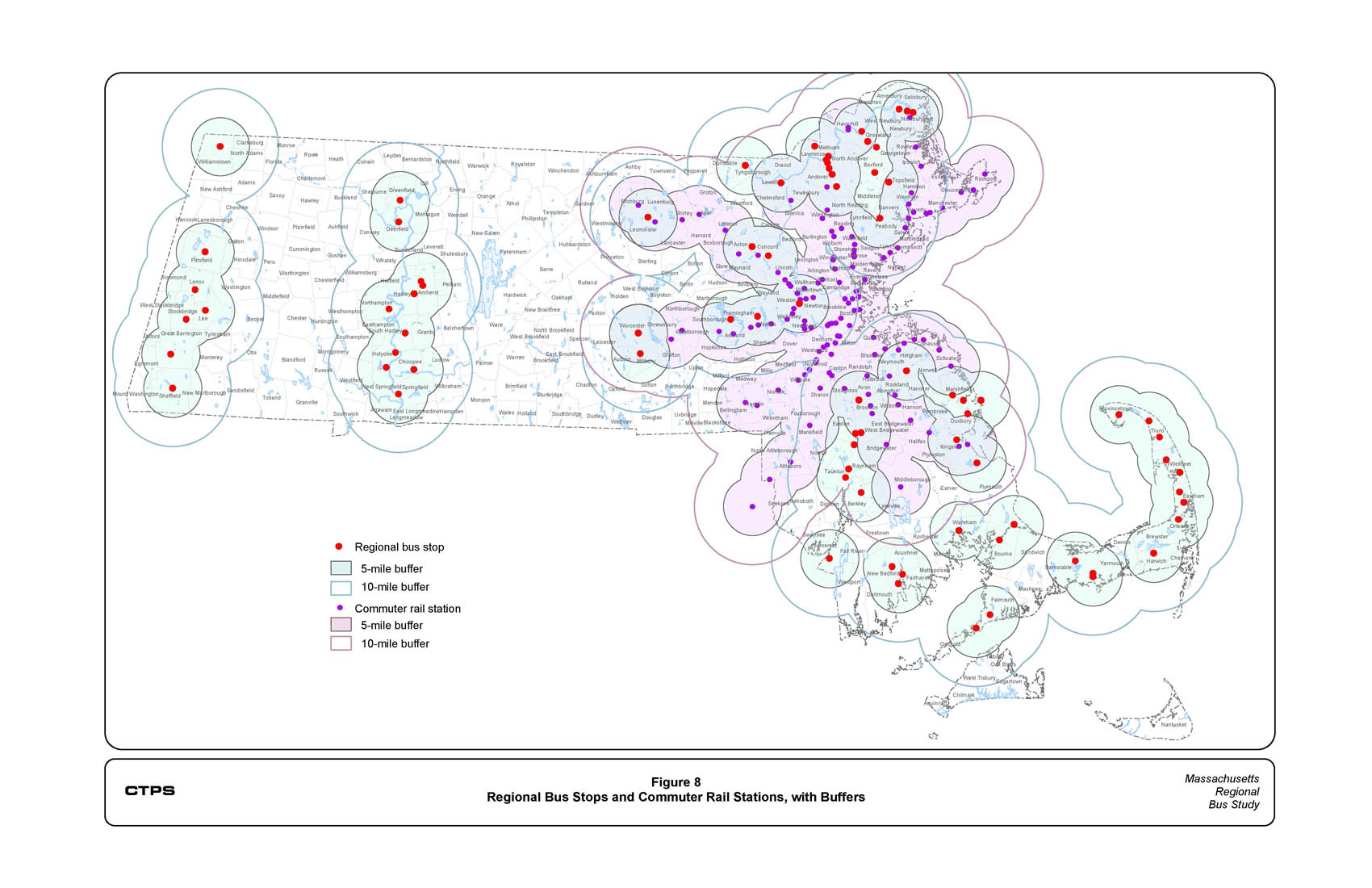
This chapter discusses the coverage provided by the state’s network of regional intercity bus and commuter rail routes. First, underserved areas in the state are identified by examining buffers surrounding regional intercity bus and commuter rail stops in relation to the location of population density and several other socioeconomic and trip-generating indicators. Potential services to these underserved areas are discussed. Second, the strengths and limitations of the network in connecting key destinations throughout the state and adjacent states, including New York City are evaluated. Finally, connectivity with the national intercity bus network is discussed.
All of the large urbanized areas within the state have direct access to regional bus service or to commuter rail service. The majority of communities with significant population density are within five miles of a regional bus or commuter rail stop.
The Federal Bureau of Transportation Statistics (BTS), in its report, The U.S. Rural Population and Scheduled Intercity Transportation in 2010: A Five-Year Decline in Transportation Access, identifies Massachusetts as having 100% coverage for access to intercity transportation in rural areas. The BTS definition of having access is living within 25 miles of an intercity regional bus stop, rail station, or airport; 100% coverage means that 100% of the population has access.
Using a stricter access criterion of a 10-mile distance to a regional fixed-route bus or rail stop, statewide coverage remains good, but does not achieve 100%. Figure 8 shows the present network with 5-mile and 10-mile buffers surrounding existing stops in the state. The majority of the state’s area is within 5 to 10 miles of a stop. The following analyses of coverage in relation to various characteristics are in terms of 5-mile buffers.
Geographical information systems (GIS) analysis is a powerful tool for visualizing network coverage and identifying potential regional transportation markets. Population and related demographic and land use data for Massachusetts are analyzed below using GIS, and several factors that might suggest latent demand for regional bus service are highlighted, specifically household income and auto ownership, average vehicle age, and elderly population density.
Figure 9 shows population density (persons per square mile) along with the 5-mile buffers surrounding existing regional bus and commuter rail stops. The figure also includes existing RTA local bus routes. As can be seen, there are five communities with a population density of 1,000 or more persons per square mile which are more than five miles from a regional bus or commuter rail stop and do not have RTA local bus service: Clinton, Hudson, Northbridge, Uxbridge, and Southbridge. If the very limited MWRTA service to Milford is disregarded, this community also falls into this group. All of Southbridge and parts of Uxbridge are more than 10 miles from the nearest regional bus or rail stop.
Seven areas with 1,000 or more persons per square mile are more than five miles from the nearest regional bus or commuter rail stop, but are served by a local fixed-route service operated by an RTA: Adams, Athol, Gardner, North Adams, Oxford, Palmer, and Ware.
Figure 10 shows the regional bus and commuter rail stops overlaid with data for annual household income. Many of the communities with lower population densities that are beyond the 10-mile coverage range of a regional bus or rail stop are communities with low household incomes.
Figures 11 and 12 show patterns of household car ownership together with the regional bus and rail coverage. Figure 11 shows vehicles owned per household by municipality. The darker shades have lower levels of car ownership, and many of these lower-ownership areas are within the regional bus and rail service corridors. The age of the vehicle fleet, however, may suggest some bus service opportunities even in high-auto-ownership areas. Figure 12 shows that older vehicles tend to be in the in areas without bus or rail service and with higher auto ownership. Households wishing to reduce dependence on their older vehicles might present a potential regional bus ridership market.
Figure 13 shows the regional bus network overlaid with the density of residents aged 65 and older. The density patterns for this age group are broadly similar to the patterns found for the overall population, shown in Figure 10.
Figure 14 shows several classes of institutional trip generators: acute-care hospitals, community health centers, colleges and universities, prisons, and military facilities. Locations such as these can be important trip generators for long-distance regional bus service. Indeed, the five-mile buffers and RTA route systems overlaid on Figure 14 suggest that the various fixed-route service providers have, to a significant degree, shaped their services to reach these locations. Acute-care hospitals in Southbridge, Milford, and Clinton are some of the few institutions that are located more than five miles from an existing regional bus or commuter rail stop and are not directly on an RTA bus route.
Figure 8 Regional Bus Stops and Commuter Rail Stations, with Buffers

Figure 9 Population Density by Census Tract (2010 Census) in Relation to Regional Bus and Commuter Rail Service

Figure 10 Median Annual Household Income by Town (2005-2009) in Relation to Regional Bus and Commuter Rail Service
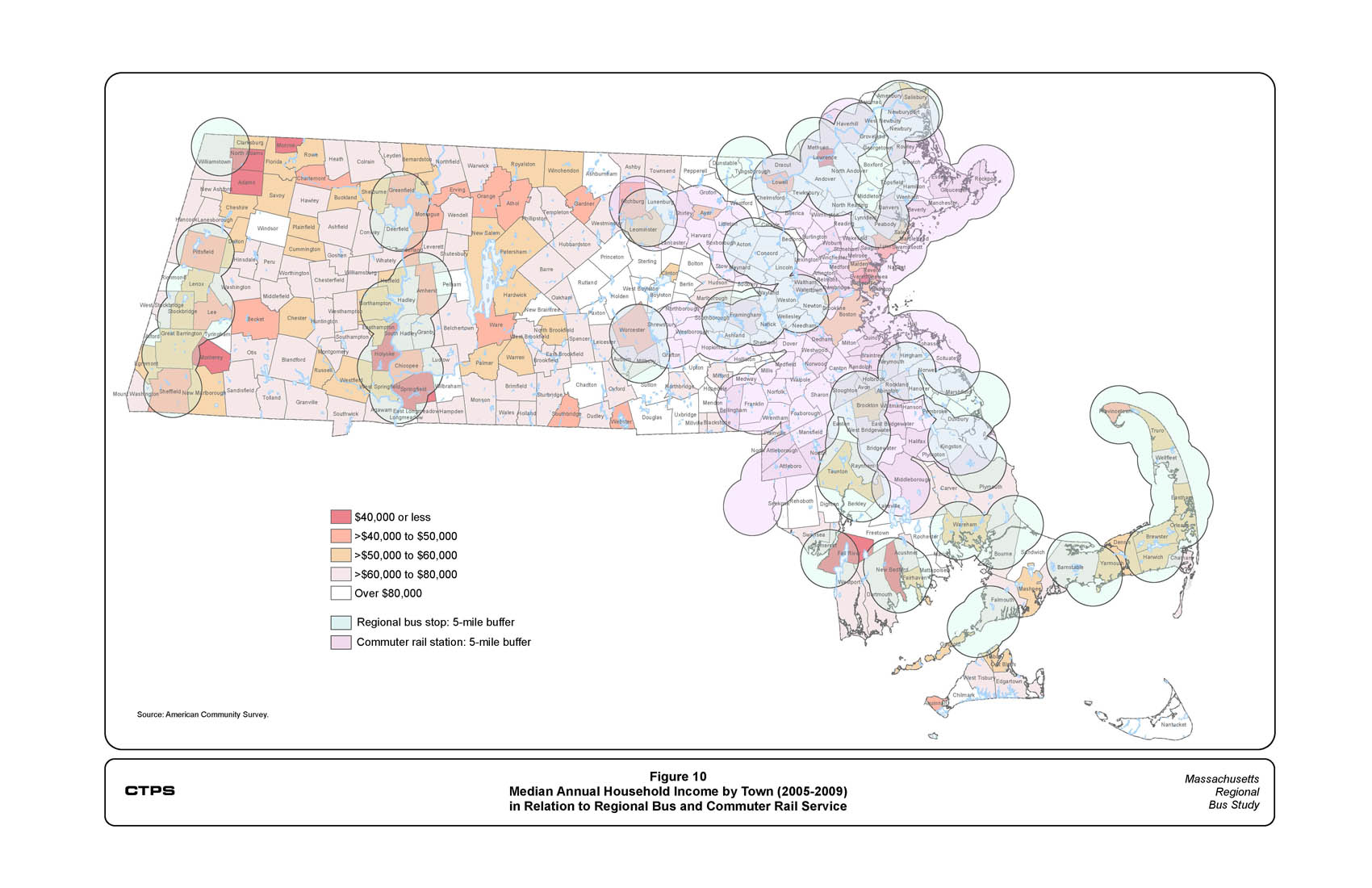
Figure 11 Vehicles per Household by Town (2005-2009) in Relation to Regional Bus and Commuter Rail Service
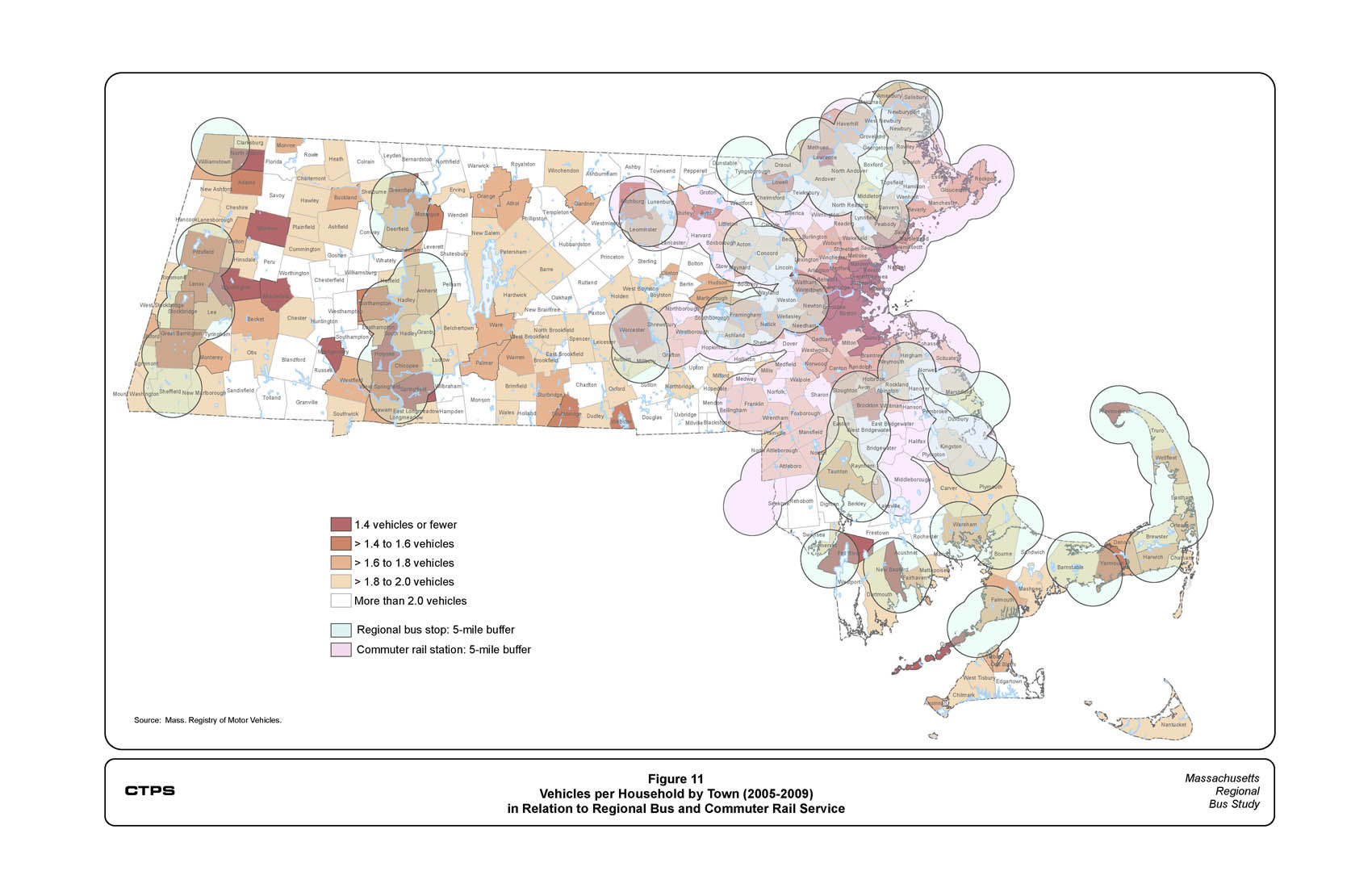
Figure 12 Median Age of Registered Vehicles, by Town (2011) in Relation to Regional Bus and Commuter Rail Service
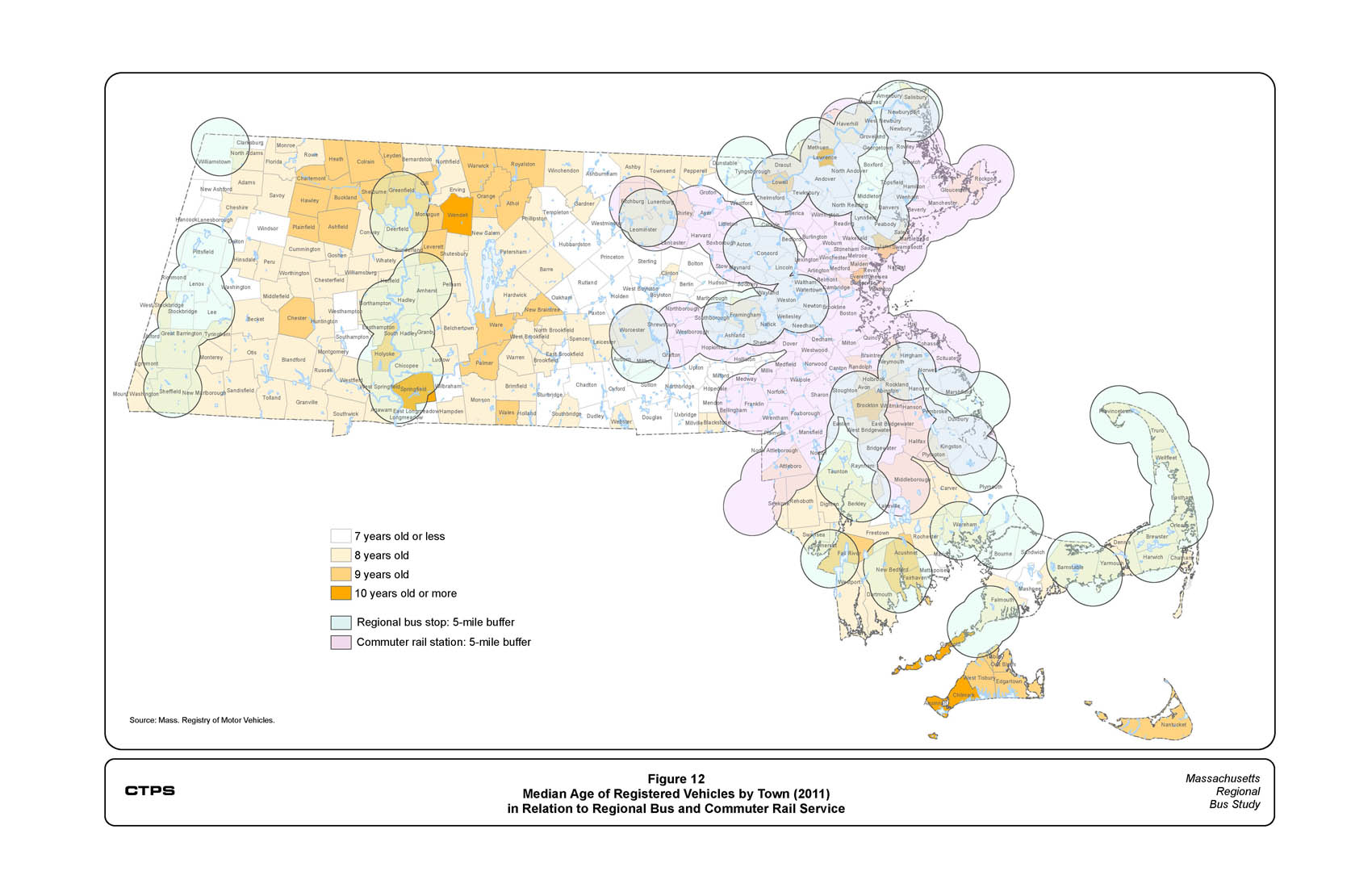
Figure 13 Population Density of Persons 65 Years Old or Older by Census Tract (2010 Census)
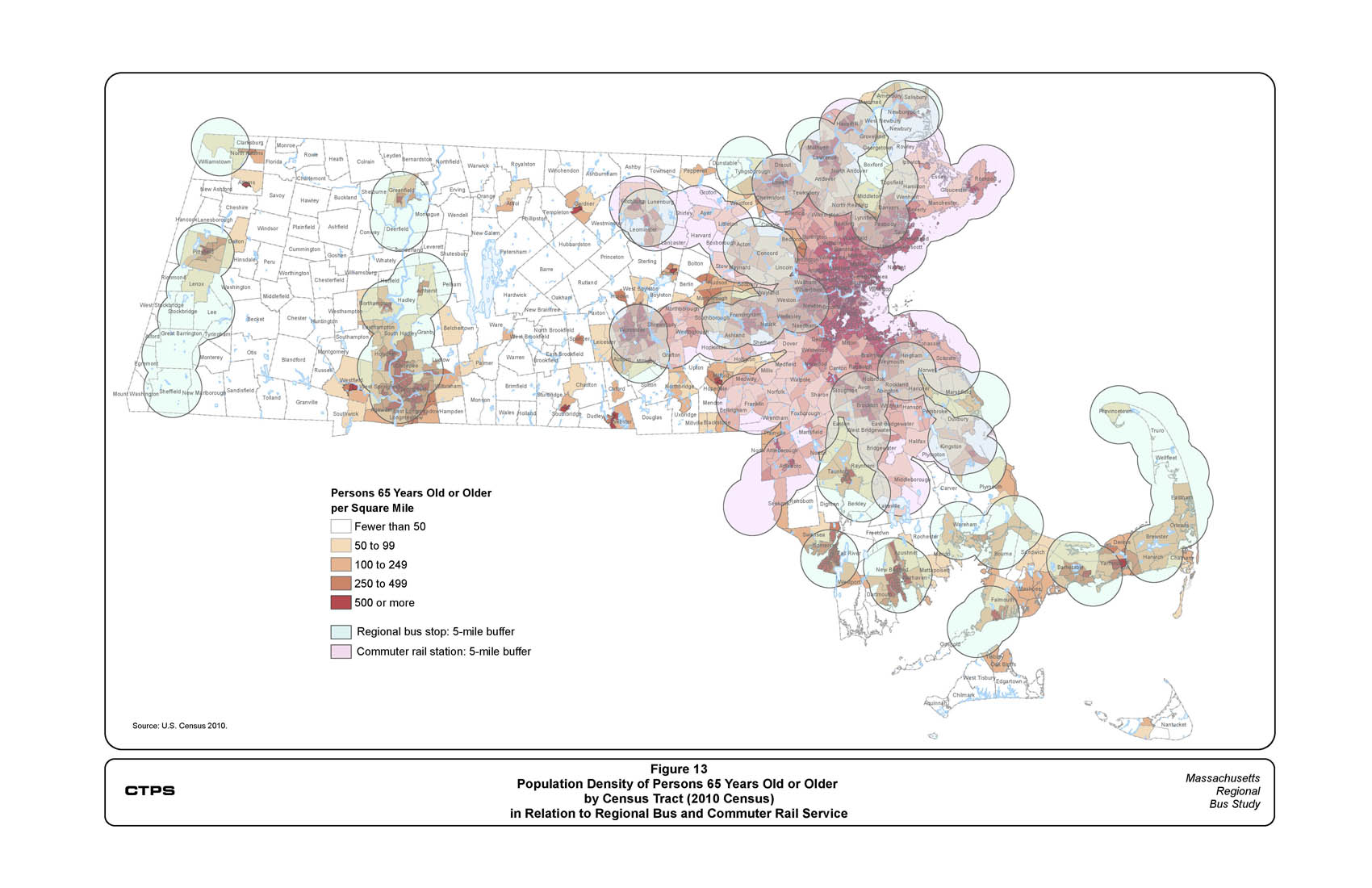
Figure 14 Major Traffic Generators in Relation to Regional Bus and Commuter Rail Service
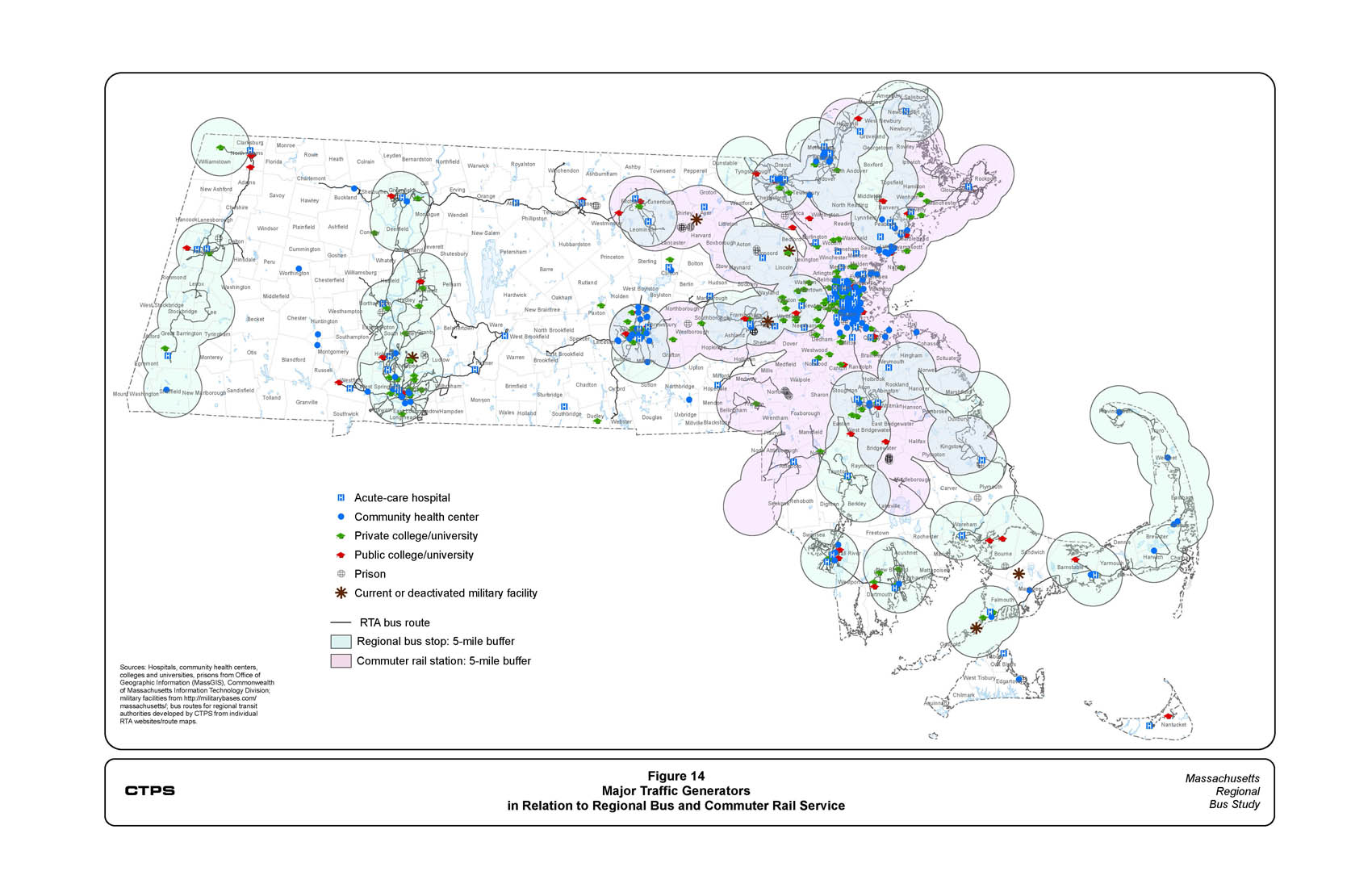
When the data presented in Figures 8 through 14 are examined, there are several clusters of underserved areas where potential new or modified services could fill gaps in the service coverage of the state. The most significant underserved areas are the following (in roughly south-to-north order):
This section first assesses the strengths and limitations of the network of regional intercity bus, regional commuter bus, Amtrak, and commuter rail services in connecting key destinations throughout the state. It then looks at connectivity with Boston and New York City. Finally, connectivity with the national intercity bus network is discussed.
The commuter rail, regional bus, and local RTA routes can be viewed as a single combined network. The approach used in this section is to identify a group of distinct urban areas in Massachusetts and evaluate the capabilities and limitations of that network for traveling between any two of these urban centers. This evaluation can be seen as, in part, an assessment of the practicality of the network as an alternative to automobile travel between the urban areas.
First, the presence or absence of connections between city-pairs is inventoried. Then the factor of schedules is considered in terms of earliest possible arrival times and latest allowable departure times.
Selected for use in this analysis were Boston and 15 other urban centers spanning the state: Haverhill, Lawrence, and Lowell north of Boston; Pittsfield, Springfield, Worcester, Fitchburg, and Framingham west of Boston; and Attleboro, Taunton, Brockton, Fall River, New Bedford, Plymouth, and Barnstable south of Boston. These urban centers and the key network elements that join them are depicted schematically in Figure 15.
The 16 urban areas in Figure 15 define a set of 120 possible city-pairs, all of which can be connected using the combined bus-rail network. Some of these city-pairs have direct and frequent service, while connections between others are problematic. Technically, all the city-pairs can be connected by transferring in Boston, though travel time compared to direct automobile travel time can be extremely onerous, and such trips may require traveling a considerable distance in a direction opposite from the final destination. An example would be a journey from Attleboro to Plymouth. Such journeys can also be very expensive, as riders must pay for a full ride from the origin point to Boston and then pay again for a trip from Boston to their final destination. With the exception of distant Pittsfield, all 15 urban areas have one or more carriers offering one-seat trips to Boston over the course of the day (Pittsfield passengers normally transfer in Springfield).
The 120 city-pairs can be divided into seven groups:
The services connecting with Boston are understandably the best developed both in speed and frequency. Indeed, transferring between two of these 15 radial routes is the “connection of last resort” for other, often tenuous city-pairs.
Of the remaining 105 city-pairs, nine have good service because they take advantage of the15 radial services to Boston. The simplest example is Haverhill and Lawrence, connected to each other by all commuter trains to Boston originating in Haverhill. P&B buses that stop in Barnstable and Plymouth, and DATTCO buses stopping in New Bedford and Taunton are additional examples of cities connected by existing radial services. Various services extend west of Boston and serve Framingham, Worcester, Springfield, and Pittsfield in various combinations making possible one- or two-seat trips between these four cities.
The 21 city-pairs between the three north-side cities and the seven south-side cities are logically connected by two radial trips. These can be two regional bus trips, two commuter rail trips, or a different mode for each segment. A connection might be made at South Station, at a nearby curbside location, or at North Station via subway.
This leaves 75 city-pairs for which the strong radial services to Boston are of little help. There are, however, a number of regional and local RTA services that, either individually or via a transfer, connect a number of these city-pairs without requiring a trip to Boston.
Local MVRTA routes between Lowell and Lawrence and between Lawrence and Haverhill, together with the commuter rail also serving Lawrence and Haverhill, complete the connectivity between these three cities. The connection between this group and the western group is more tenuous.
Peter Pan operates a single round-trip service from Concord, New Hampshire, to Worcester with stops in Lowell and Leominster. On the day this trip was surveyed by CTPS, however, there were no passengers making in-state trips; all were either transferring from New York buses or traveling to locations in New Hampshire. Travelers from Lowell, Lawrence, and Haverhill to Worcester and Framingham can take the circuitous but more frequent commuter trains via Boston, which could be more attractive when compared with Peter Pan’s limited schedule.
Fitchburg is isolated from the strong east-west bus routes that serve the other west-side cities using the Massachusetts Turnpike. Fitchburg travelers can avail themselves of the daily Peter Pan bus that runs between nearby Leominster and Worcester. The Peter Pan service has been recently supplemented by a MART service between Fitchburg and Worcester that was previously limited to persons needing transportation to medical facilities but is now open to the general public. Despite the proximity of Fitchburg and Worcester, the only transit alternative between the two areas previously involved travel via Boston. Traveling from Fitchburg to Worcester via Boston is not only time consuming but also very expensive, requiring riders to pay for two lengthy trips in order to reach their final destination.
Several regional bus and local RTA routes connect some pairs of the seven south-side cities and some city-pairs between the south side and the west side. Peter Pan service from Hyannis to Providence also connects Bourne, New Bedford, and Fall River with each other. The CTPS survey of passengers on this route, though, found only a small percentage of riders traveling only within Massachusetts (such as Hyannis to New Bedford). The majority of riders were traveling to Providence or New York.
Peter Pan also provides direct service from Providence to Worcester which continues to Springfield and Pittsfield. Transfers can be made in Providence to Peter Pan’s Providence– Hyannis service. This allows for direct trips from Hyannis, New Bedford, or Fall River to Worcester, Springfield, or Pittsfield with a single transfer in Providence.
Bloom operates very limited service between Taunton and Brockton, and the only fixed-route alternative for travel between these two communities is by transfer in Boston.
DATTCO service from New Bedford to Boston stops at the Galleria Mall in Taunton. While the majority of riders from both stops are traveling to Boston, there are some passengers each day traveling between New Bedford and Taunton; a connection can be made at the Galleria to local GATRA service. DATTCO connects in New Bedford with Peter Pan service to Hyannis, allowing for journeys such as Taunton to Hyannis without traveling via Boston.
The two local RTAs in this area, GATRA and SRTA, also serve some city-pairs directly. SRTA operates frequent local service between New Bedford and Fall River, connecting with regional carriers in both cities. GATRA operates service between Attleboro and Taunton, connecting in Attleboro with the MBTA’s commuter rail service to Providence.
Figure 15 Urban-Area-to-Urban Area Schematic

The travel time and cost of a trip are not the only important user considerations. The available services between a city-pair, in both directions, should allow for a reasonably convenient morning arrival time (no later than 9:00 AM), as well as a convenient departure time in the afternoon (no earlier than 5:00 PM). Even with multiple possible arrivals and departures throughout a weekday, the earliest possible arrival and latest possible departure are important factors determining how closely connected two cities are by fixed-route surface modes.
These outside arrival/departure limits are determined by a combination of factors. If commuters are a major part of ridership, carriers will design schedules to accommodate that market. In less well-defined travel markets, a number of factors become relevant, such as the distance between cities and the size of the travel market. The location of a carrier’s garage or storage lot and its fleet utilization practices are also important, especially for smaller travel markets.
Table 32 shows the earliest possible arrival time between city-pairs for those cities which do not have an arrival before 9:00 AM. All city-pairs that offer arrivals before 9:00 AM are marked with an asterisk (*).
All but one of the urban areas outside of Boston has a departure that will arrive in Boston before 9:00 AM. The exception is Pittsfield, where the earliest bus departure will reach Boston at 2:45 PM.
For Pittsfield, Springfield, or Fitchburg, no bus or rail service arrives prior to 9:00 AM from any of the other 15 urban areas. The earliest arrival in Pittsfield is a bus from Springfield at 1:35 PM. Springfield can be reached from most other urban areas in the state by 10:10 AM. This is when the earliest bus from Boston arrives. Springfield cannot be reached from Framingham or Fall River until 11:35 AM, from Pittsfield until 11:40 AM, or from Barnstable until 12:15 PM. The earliest arrival in Fitchburg is 10:15 AM, via commuter rail from Boston. By transferring in Boston, it is possible to reach Fitchburg by 10:15 AM from all but one of the 14 remaining urban areas reviewed. The earliest possible arrival in Fitchburg from Pittsfield, however, is 5:59 PM.
For each of the remaining 12 urban areas, the level of early arrival times is better than for Pittsfield, Springfield, and Fitchburg, but at least one of the other 15 urban areas lacks a rail or bus departure that will arrive before 9:00 AM. These post–9:00 AM earliest arrivals include:
Table 32
Earliest Arrival Times for City Pairs
To From |
Boston |
Haverhill |
Law-rence |
Lowell |
Pittsfield |
Springfield |
Worcester |
Fitchburg |
Framingham |
Attleboro |
Taunton |
Brockton |
Fall River |
New Bedford |
Plymouth |
Barnstable |
Boston |
* |
* |
* |
* |
1:35 PM |
10:10 AM |
* |
10:15 AM |
* |
* |
* |
* |
* |
* |
* |
* |
Haverhill |
* |
* |
* |
* |
1:35 PM |
10:10 AM |
* |
10:15 AM |
* |
* |
* |
* |
* |
* |
* |
* |
Lawrence |
* |
* |
* |
* |
1:35 PM |
10:10 AM |
* |
10:15 AM |
* |
* |
* |
* |
* |
* |
* |
9:45 AM |
Lowell |
* |
* |
* |
* |
1:35 PM |
10:10 AM |
* |
10:15 AM |
* |
* |
* |
* |
* |
* |
* |
9:45 AM |
Pittsfield |
2:45 PM |
5:41 PM |
5:29 PM |
3:54 PM |
* |
11:40 AM |
1:15 PM |
5:59 PM |
3:35 PM |
4:31 PM |
3:40 PM |
4:16 PM |
2:35 PM |
2:35 PM |
5:15 PM |
3:40 PM |
Springfield |
* |
11:38 AM |
11:26 AM |
9:54 AM |
1:35 PM |
* |
11:15 AM |
10:15 AM |
* |
10:43 AM |
* |
9:02 AM |
10:20 AM |
10:20 AM |
* |
10:45 AM |
Worcester |
* |
* |
* |
* |
1:35 PM |
10:10 AM |
* |
10:15 AM |
* |
* |
* |
* |
10:20 AM |
10:20 AM |
* |
9:45 AM |
Fitchburg |
* |
* |
* |
* |
1:35 PM |
11:35 AM |
* |
* |
* |
* |
* |
9:02 AM |
* |
* |
* |
9:45 AM |
Framingham |
* |
* |
* |
* |
1:35 PM |
11:35 AM |
* |
10:15 AM |
* |
* |
* |
* |
* |
* |
* |
9:45 AM |
Attleboro |
* |
* |
* |
* |
1:35 PM |
10:10 AM |
* |
10:15 AM |
* |
* |
* |
* |
* |
* |
* |
* |
Taunton |
* |
* |
* |
* |
1:35 PM |
10:10 AM |
* |
10:15 AM |
* |
* |
* |
* |
* |
* |
* |
* |
Brockton |
* |
* |
* |
* |
1:35 PM |
10:10 AM |
* |
10:15 AM |
* |
* |
* |
* |
* |
* |
* |
* |
Fall River |
* |
9:16 AM |
9:04 AM |
* |
1:35 PM |
10:10 AM |
10:16 AM |
10:15 AM |
* |
* |
* |
9:02 AM |
* |
* |
* |
9:45 AM |
New Bedford |
* |
* |
* |
* |
1:35 PM |
10:10 AM |
* |
10:15 AM |
* |
* |
* |
* |
* |
* |
* |
* |
Plymouth |
* |
* |
* |
* |
1:35 PM |
10:10 AM |
* |
10:15 AM |
* |
* |
* |
* |
* |
* |
* |
* |
Barnstable |
* |
* |
* |
* |
1:35 PM |
12:15 PM |
10:45 AM |
10:15 AM |
10:45 AM |
* |
* |
* |
* |
* |
* |
* |
* = The city pair has one or more arrivals before 9:00 AM.
For a majority of Massachusetts same-day urban-area-to-urban-area journeys via rail or bus, the last departures available for the return trip are after 5:00 PM. There are several exceptions, however, most of them related to Pittsfield.
The last departure time for eastbound bus service from Pittsfield to Springfield that connects to points east is 4:35 PM. As mentioned above, the earliest arrival from Boston is at 2:45 PM, less than two hours earlier, so the 4:35 departure means a very short day trip from Boston for bus riders.
Travel to Pittsfield in the late afternoon requires changing buses in Springfield. To connect with the last bus from Springfield to Pittsfield it is necessary to take a bus that leaves Boston at 4:00 PM and Worcester at 5:10 PM. Riders from Framingham, Lawrence, Lowell, Plymouth, and Taunton would need to depart from their respective cities at various earlier times between 2:00 PM and 3:45 PM in order to make the connection at Springfield. Riders from Attleboro, Barnstable, Brockton, Fitchburg, Haverhill, Lawrence, and New Bedford would need to depart from their respective cities at even earlier times, between noon and 1:45 PM, to make the connection at Springfield. For most of these origins a transfer would be required in Boston. Only Worcester and Springfield in central Massachusetts have departures after 5:00 PM that reach Pittsfield the same day.
In order to reach Springfield on the same day, it is necessary to leave before 5:00 PM if the trip begins in Barnstable (a 4:30 PM departure is necessary), Fall River (4:00 PM departure), Fitchburg (3:05 PM departure), or Pittsfield (4:35 PM departure).
Services from the 15 urban areas to Boston and New York are summarized in Table 33.
Direct service to Boston is available from all of the other 15 Massachusetts urban areas in the sample. The service from Pittsfield is not as good as that from the other areas. Direct daily service between Pittsfield and Boston is provided by Amtrak’s Lake Shore Limited train serving Chicago. This service can be vulnerable to extreme delays in the eastbound direction and may not be well suited for an in-state trip. The more frequent bus service from Pittsfield requires a transfer in Springfield.
Direct service to New York City is available on regular schedules from Framingham (Limoliner), Springfield (Peter Pan/Greyhound and Amtrak), and Pittsfield (Peter Pan).
Some direct service between Worcester and New York is provided by Peter Pan/Greyhound pooled service. The majority of the Peter Pan/Greyhound trips, however, require a transfer in Hartford. There are commercial van operators providing scheduled service from Worcester to New York City that are marketed primarily to the Spanish-speaking community. The availability of this service may limit the demand for direct regional bus service between Worcester and New York City without the transfer at Hartford.
Friday- and Sunday-only through service in the summer is available from Megabus from Barnstable. Peter Pan sells through-tickets year-round between Barnstable, Fall River, and New Bedford and New York City; these trips require a short layover in Providence. On many trips, the same equipment will operate through from Cape Cod to New York City.
Table 33
Availability of Direct Service to Boston and New York
Urban area |
Direct Service to Boston |
Transfer Location to Boston for Non-Direct Service |
Direct Service to New York City |
Transfer Location to New York City for Non-Direct Service |
Worcester |
Rail and Bus |
|
Bus, limited schedule |
Bus at Hartford |
Springfield |
Rail and Bus |
|
Rail and Bus |
|
Lowell |
Rail |
|
|
Bus at Worcester Rail at Boston |
New Bedford |
Bus |
|
Bus |
|
Brockton |
Rail |
|
|
Rail at Boston |
Fall River |
Bus |
|
Bus |
|
Lawrence |
Rail and Bus |
|
|
Rail at Boston |
Framingham |
Rail and Bus |
|
Bus |
Bus at Hartford or Springfield |
Haverhill |
Rail and Bus |
|
|
Rail at Boston |
Plymouth |
Rail and Bus |
|
|
Bus or Rail at Boston |
Taunton |
Bus |
|
|
Bus at Boston |
Barnstable |
Bus |
|
Bus |
|
Pittsfield |
Rail |
Bus at Springfield |
Bus |
|
Attleboro |
Rail |
|
|
Rail at Providence |
Fitchburg |
Rail |
|
|
Rail at Boston |
A number of fixed-route services connect Massachusetts communities other than Boston with locations in a neighboring state. This section describes currently operating multistate services, including Amtrak trains, commuter rail service, regional bus routes, and RTAs’ local bus routes. The descriptions are presented in geographical order, beginning with the border with New Hampshire near the Atlantic Ocean and continuing counterclockwise along the Massachusetts state line to Aquidneck Island in Rhode Island.
C&J bus service connects Portsmouth, Dover, and Durham, New Hampshire, with Newburyport, entering Massachusetts on I-95 in Salisbury. Other regional carriers operating on this route primarily serve Boston.
Amtrak Downeaster service connects Woburn and Haverhill in Massachusetts with Exeter, Durham, and Dover, New Hampshire, as well with four locations in Maine. A significant number of commuters take the Downeaster to Woburn or Haverhill, even from Maine, though commuters using that service are mostly destined for North Station.
MVRTA operates local service from Haverhill to State Line Plaza in Plaistow (MVRTA Route 13). MVRTA also operates special summer-only service from Hampton Beach, New Hampshire, to Haverhill and Lawrence via Amesbury (MVRTA Route 83).
LRTA Route 10 operates between Lowell and Hudson, New Hampshire, stopping just over the state line. During the holiday season, the LRTA operates special bus service from Lowell direct to the Pheasant Lane Mall in Nashua, New Hampshire.
Boston Express buses between Manchester and Nashua, New Hampshire, and Boston make an intermediate stop in Tyngsborough on all trips throughout the day. There are no nearby trip generators in Tyngsborough, however, and Boston Express does not offer tickets for trips between Tyngsborough and New Hampshire.
Peter Pan operates one daily trip each way between Concord, Manchester, and Nashua, New Hampshire, and Lowell, Leominster, and Worcester. At one time, Vermont Transit (now part of Greyhound) also stopped in Lowell on its Montreal–Boston route. Peter Pan is now the only carrier connecting Lowell to locations in New Hampshire.
Greyhound offers daily direct service between Springfield, Greenfield and Keene, New Hampshire.
Greyhound’s daily trip between Springfield, Greenfield, and Keene, New Hampshire, also makes three stops in Vermont at Brattleboro, Bellows Falls, and its terminus, White River Junction.
The Green Mountain Community Network operates local bus routes in Bennington, Vermont. Two round-trips between Bennington and Williamstown, Massachusetts, are operated on weekdays.
The Amtrak Vermonter operates a daily round-trip connecting Springfield and Amherst with Brattleboro Vermont and continuing through Claremont, New Hampshire, to Windsor, White River Junction, Randolph, Montpelier, Waterbury, Essex Junction, and St. Albans, Vermont.
Peter Pan operates service between Albany, New York, and Pittsfield, Lenox, Lee, Springfield, and Worcester. Although the bus travel time from Pittsfield to Albany is only 50 minutes, current schedules do not facilitate commuting to Albany (the earliest arrival in Albany from Pittsfield is 2:30 PM).
Greyhound typically operates three daily round-trips between Albany and Boston, with an intermediate stop in Worcester. West of Worcester, the route follows I-90, as any added stop would need to be near a toll plaza so as not to degrade travel times.
Peter Pan operates two daily round-trips between Williamstown and New York City. This route serves intermediate stops at Pittsfield, Lenox, Lee, Stockbridge, Great Barrington, and Sheffield in Massachusetts, and Canaan, Winsted, Torrington, Waterbury, Southbury, and Danbury in Connecticut.
Peter Pan and Greyhound operate their pooled service between Boston and Hartford with intermediate stops in Framingham and Worcester. They also operate a pooled service between Springfield and New York City with a stop in Hartford. This route operates nonstop on I-91 between Springfield and Hartford.
The Bradley International Airport serves greater Springfield and Hartford, and is located in Connecticut midway between these two cities. Peter Pan discontinued service to Bradley Airport a number of years ago, and there is currently no fixed-route service connecting the airport with Massachusetts.
Amtrak operates several daily trips between Springfield and New York City. Almost all the stops on this route are in Connecticut, including Windsor Locks, Windsor, Hartford, Berlin, Meriden, Wallingford, New Haven, Bridgeport, and Stamford.
PVTA operates local bus Route 5 between Springfield and Enfield, Connecticut. Connections can be made in Enfield with local Connecticut Transit (CT Transit) buses serving Hartford.
Peter Pan offers some daily trips between Springfield and Providence with an intermediate stop in Worcester. This route runs through the Blackstone Valley on Route 146.
Frequent MBTA commuter rail service on the Providence Line makes local Massachusetts stops in Westwood, Sharon, Mansfield, and Attleboro. Several of the trains to Providence have recently been extended to stops at T. F. Green Airport and Wickford Junction.
GATRA Routes 11 and 24 provide service between Attleboro and Pawtucket, Rhode Island, where a connection can be made to Rhode Island Public Transit Authority (RIPTA) Route 77. GATRA Route 16 operates to a point in Seekonk only a quarter mile away from RIPTA Route 76.
Peter Pan operates direct service between Providence and Fall River, New Bedford, Bourne, and Hyannis, entering Massachusetts via I-195 in Seekonk. As presently scheduled, it is possible to commute to Providence on this service. A recent CTPS survey, however, did not show any daily commuters utilizing the service.
Peter Pan operates several daily round-trips between Newport, Rhode Island, and Boston. These buses also make an intermediate stop at Fall River, as well as pick up or drop off passengers locally in the Rhode Island communities of Portsmouth and Middleton.
The urbanized neighborhoods of Blackstone and Bellingham blend into Woonsocket, Rhode Island, across an invisible urban state boundary. Blackstone is not a member of an RTA, and Bellingham’s one GATRA route is on the side of the town farthest from Woonsocket. An arrangement to extend one or more local RIPTA routes into these communities from Woonsocket might merit consideration.
Greyhound and Peter Pan service from Massachusetts connects to points outside New England and to the rest of the national bus network in New York City and Albany. Greyhound service from Boston to Montreal connects directly to the Canadian intercity bus network in Montreal.
Megabus operates direct service between Boston and New York City, Philadelphia, and Washington D.C. Megabus also operates multiple routes connecting New York with points south and west. Passengers cannot, however, directly purchase through-tickets, but must purchase individual tickets for connecting segments.
The National Bus Traffic Association (NBTA) is the single processing agent for interline through-tickets for scheduled intercity and regional bus service in the United States. Membership in the association is voluntary. Member carriers can sell tickets through to any destination served by a member carrier in the United States and Canada. Greyhound Lines is by far the largest member. While the majority of members are private carriers, public transit authorities, mostly in rural areas, have joined the association in recent years.
Of the 19 private carriers serving Massachusetts, six participate in the NBTA: Greyhound, Peter Pan, Concord Coach, C&J, Plymouth & Brockton, and Boston Express. Boston Express only places some of its routes into the NBTA system.
The non-NBTA members operating in Massachusetts tend to be the peak-period-only commuter routes, or direct-express operators that primarily sell tickets on line: Bloom, Bolt, Coach Company, Dartmouth Coach, DATTCO, Megabus, MVRTA, Fung Wah, Hampton Jitney, Lucky Star, Yankee, and World Wide. Passengers from five of these carriers, Bloom, Coach Company, DATTCO, MVRTA, and Yankee, were surveyed by CTPS as part of this study. The DATTCO respondents reported a high level of transfer activity at South Station with other regional bus services. Interline ticketing through NBTA could simplify travel between New Bedford and upper New England.
Also, Amtrak has its “Thruway” connecting bus ticketing program. Concord Coach and C&J both have agreements to sell through-tickets with Amtrak, as well as being NBTA members.
A rural feeder service that interlines with Greyhound or other intercity carriers must have Federal Motor Carrier Safety Administration (FMCSA) operating authority and meet insurance and safety standards, even if it does not cross a state line. According to Greyhound, the advantage of a full interline agreement includes nationwide ticketing and inclusion in the Greyhound phone- and internet-based ticketing system. Greyhound prefers that rural feeders be scheduled rather than demand-response, have proper operating authority and insurance, operate daily, not duplicate any pre-existing intercity bus service, and allow for full ticketing and package express services.
NBTA sponsorship requires a transit agency to pay a membership fee of $25 and an annual fee of $100. Feeder services crossing state lines must meet full FMCSA insurance requirements. Carriers not crossing state lines are only required to meet state insurance requirements. Rural agents who sell tickets must execute a Standard Independent Commission Agreement specifying obligations for sale of tickets, accounting requirements, reporting on payment requirements, and related liability issues.
None of the RTAs in Massachusetts is a member of NBTA; there are no interline tickets available to or from an RTA service. The majority of the RTA services that connect with regional carriers in Massachusetts would be considered urban transit services based on the nature of the routes and types of equipment operated. PVTA services in Amherst and Springfield, WRTA services in Worcester, and SRTA services in New Bedford and Fall River are primarily short urban routes. The RTAs in the state with longer-distance rural service are FRTA and BRTA. FRTA connects with Peter Pan and Greyhound service in Greenfield, and BRTA connects with Peter Pan in Pittsfield.